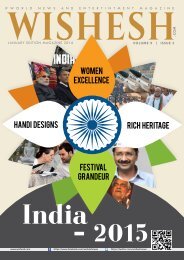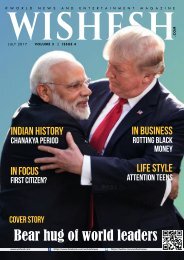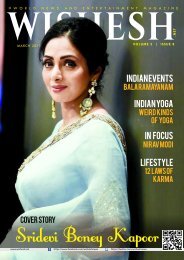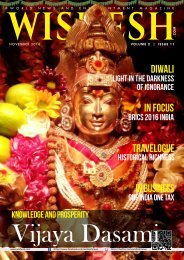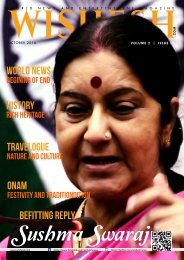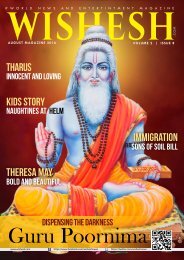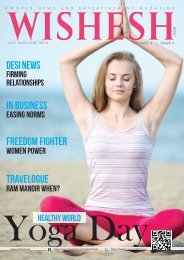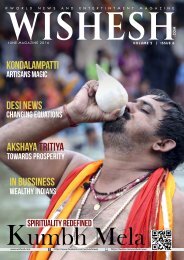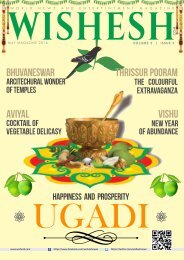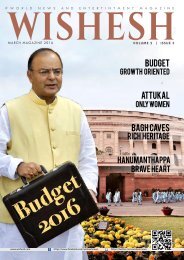Wishesh December Magazine 2015
Wishesh December Magazine has more excited stories of Diwali Festival of Lights, Karatar Singh Sarabha was an Indian Sikh revolutionary, Indra Nooyi Chairman of PepsiCo, Infocus of Make in India, Mark Zukerberg India Visit, Healthly Romantic Tips and many more on this month magazine.
Wishesh December Magazine has more excited stories of Diwali Festival of Lights, Karatar Singh Sarabha was an Indian Sikh revolutionary, Indra Nooyi Chairman of PepsiCo, Infocus of Make in India, Mark Zukerberg India Visit, Healthly Romantic Tips and many more on this month magazine.
You also want an ePaper? Increase the reach of your titles
YUMPU automatically turns print PDFs into web optimized ePapers that Google loves.
INDIAN DIASPORA<br />
The fearless<br />
Nihang<br />
The Nihang are the<br />
popular armed Sikh order.<br />
20<br />
N<br />
They are even referred to as Akali,<br />
meaning immortals. Nihang’s origin<br />
is believed to be from Fateh Singh,<br />
the youngest of Guru Gobind Singh.<br />
Nihang is even expected to<br />
take its origin from a Persian<br />
word, meaning a mythical sea<br />
creature. The term owes its<br />
origin to Mughal historians, who<br />
compared the Akali’s ferocity<br />
with the crocodiles.<br />
In Raag Aasa, Guru Arjan dev<br />
Ji has described ‘Nihang’ as<br />
those, who lives with no fear.<br />
Nihang’s attire<br />
Nihang’s traditional dress<br />
is called Shiva Swarupa,<br />
meaning “Shiva’s appearance”.<br />
It comprises of superelectric<br />
blue in full attire, iron bracelets,<br />
round the wrists called Jangi<br />
Kara and quoits of steel called<br />
‘Chakram’, blue turbans on<br />
WWW.WISHESH.COM | DECEMBER <strong>2015</strong><br />
head, and along with these, a<br />
sword called ‘Kirpan’.<br />
Fully armed attire of<br />
Nihang<br />
Now, coming to the fully<br />
armed attire, a Nihang will<br />
bear one or two swords (be it<br />
the curved one or the straight<br />
khanda) on his right hip and<br />
a katara (dagger) on the left<br />
hip, a buckler made from<br />
buffalo-hide (dhala) on the<br />
back, a large chakram around<br />
the neck, and an iron chain.<br />
During the war, arms worn on<br />
the Nihang would generally<br />
be reserved until the warrior<br />
lost the weapon he held.<br />
‘‘<br />
In Raag Aasa,<br />
Guru Arjan<br />
dev Ji has<br />
described<br />
‘Nihang’ as<br />
those, who<br />
lives with no<br />
fear.<br />
‘‘





